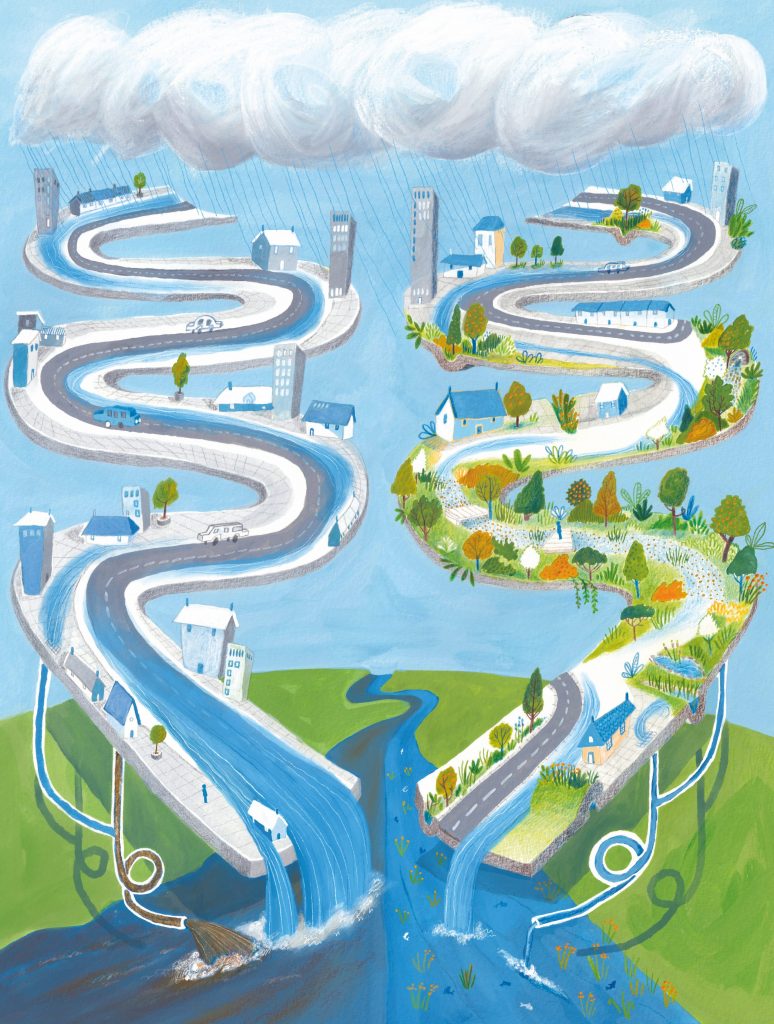Flood Mitigation: Soft Engineering

What is soft engineering?
Traditionally, shore stabilizations have been constructed using hard engineering methods with materials such as steel and concrete to protect developments from erosion due to flooding. Soft engineering is a natural form of flood mitigation that builds along shorelines to protect areas from flooding. Often referred to as riparian zones, this technique establishes local vegetation along water banks to create shore stabilization through complex root structures. Applied to water systems, soft engineering is proven to reduce erosion, while at the same time protecting local habitats along river, lake, and ocean shorelines [i].
Note that we have used the term “soft engineering” as a generic term to include a wide variety of approaches. Some related labels and approaches include “Green infrastructure” [ii], “Nature-based Solutions” (NbS) [iii], “Sustainable Drainage Systems” (SuDS) [iv], and Ecosystem-based Adaptation (EbA) [v].
How does this option help to mitigate the impacts of a flood?
Soft engineering systems built along rivers, lakes, and oceans soften the land-water boundary and promote ecological value. Examples of soft engineering include afforestation, in which trees are planted where there was no previous cover closer to rivers to slow down flood waters; ecosystem management, which integrates human and natural needs of the river; and planning to control developments along riverbanks [vi]. Therefore, in times of flooding, infrastructure damage and costs remain low while the natural shoreline facilitates high water levels.
In relation to soft engineering practices and ecosystem management, the protection and management of healthy riparian areas that border bodies of water is of paramount importance. Riparian areas may or may not require bank stabilization or erosion control measures due to their ecosystem, which acts as a transition area between water and land [vii].
Is soft engineering already in use?
In Alberta, soft engineering has been utilized for some shoreline areas along the Bow and Elbow rivers in newer communities in the City of Calgary [viii]. Globally, soft engineering is being implemented by many countries [ix]. There are also examples in Canada dating from the 1970s, although the approach is relatively underutilized [x].
What are the costs to build and maintain?
Soft engineering flood mitigation options are typically less expensive than hard engineering options, due to the use of fewer materials, natural succession, and minimal construction costs. Major costs associated with soft engineering practices include the compensation of land to those landowners giving up property for flood mitigation and maintenance costs [xi].
How long does it take to build?
Soft engineering options, such as constructing wetlands, creating flood designated areas, and strengthening riverbanks through rebuilding riparian zones, take little time to implement. Depending on the situation and the approach used, however, soft engineered solutions can take years to see the full benefit as natural ecologies return.
What is the lifetime expectancy of soft engineering?
Continual maintenance of some soft engineering practices, such as riverbank reinforcement, is required to ensure longer lifetime expectancy.
What are the associated risks?
While soft engineering options tend to work with water ways and pursue a natural approach to flood mitigation, this approach can take a long time to prove beneficial. For example, for riverbank protection to be effective, a certain amount of vegetative growth must occur. The risk with this approach is that flooding can occur before the riverbank protection (or other soft engineering option) is fully constructed, resulting in more damage.
What are the impacts on the surrounding watershed system and environment?
Soft engineering options help to regulate flooding and slow down flood waters. The controlling features of soft engineering measures, however, depend on the size of the flood and natural area. Impacts on the surrounding watershed system can be extensive, in that lakes, ponds, wetlands, streams, rivers, and groundwater can act as storage facilities for excess water in a flood [xii].
Would soft engineering help in a drought?
Soft engineering protects natural areas. Enhancing a protected area of land where wetlands, forests, and vegetation exist ensures regulated flows and water retention capabilities. Also, slowing the runoff of any precipitation will improve absorption by the ground and help recharge groundwater aquifers.
Sources:
[i] Soft Engineering and Hard Engineering – Law Essays (lawaspect.com). Accessed 2023-05-01.
[ii] European Commission, n.d., Green infrastructure. https://environment.ec.europa.eu/topics/nature-and-biodiversity/green-infrastructure_en. Accessed 2023-05-23.
[iii] International Union for Conservation of Nature, n.d., Disaster Risk Reduction. https://www.iucn.org/our-work/topic/disaster-risk-reduction. Accessed 2023-05-23.
[iv] British Geological Survey, n.d., Sustainable drainage systems. https://www.bgs.ac.uk/geology-projects/suds/. Accessed 2023-05-23.
[v] Secretariat of the Convention on Biological Diversity, 2019, Voluntary guidelines for the design and effective implementation of ecosystem-based approaches to climate change adaptation and disaster risk reduction and supplementary information. Technical Series No. 93. https://www.cbd.int/doc/publications/cbd-ts-93-en.pdf. Accessed 2023-05-23.
[vi] Use green engineering techniques instead of hard bank protection (ecrr.org). Accessed 2023-05-01.
[vii] Protecting and restoring riparian areas, Kusler, J., 2016. (nawm.org). Accessed 2023-05-01.
[viii] City of Calgary’s Riparian Action Plan (2017). Accessed 2023-05-01.
[ix] Hausman, H., 2019, Soft vs Hard Engineering for Coastal Defense Adaptation. https://climate.org/soft-vs-hard-engineering-for-coastal-defense-adaptation/. Accessed 2023-05-02.
[x] Vouk, I., et al, 2021, Nature-Based Solutions for Coastal and Riverine Flood and Erosion Risk Management. https://www.csagroup.org/wp-content/uploads/CSA-Group-Research-Nature-Based-Solutions-for-Coastal-and-Riverine-Flood-and-Erosion-Risk-Management.pdf. Accessed 2023-05-23.
[xi] Caulk A.D, et al, 2000, Best Management practices for soft engineering of shorelines. https://scholar.uwindsor.ca/cgi/viewcontent.cgi?article=1007&context=softs. Accessed 2023-05-02.
[xii] “Environmental Aspects of Integrated Flood Management.” World Meteorological Organization. Switzerland; 2006; pg. 25-28. https://www.floodmanagement.info/publications/policy/ifm_env_aspects/Environmental_Aspects_of_IFM_En.pdf. Accessed 2023-05-02.


